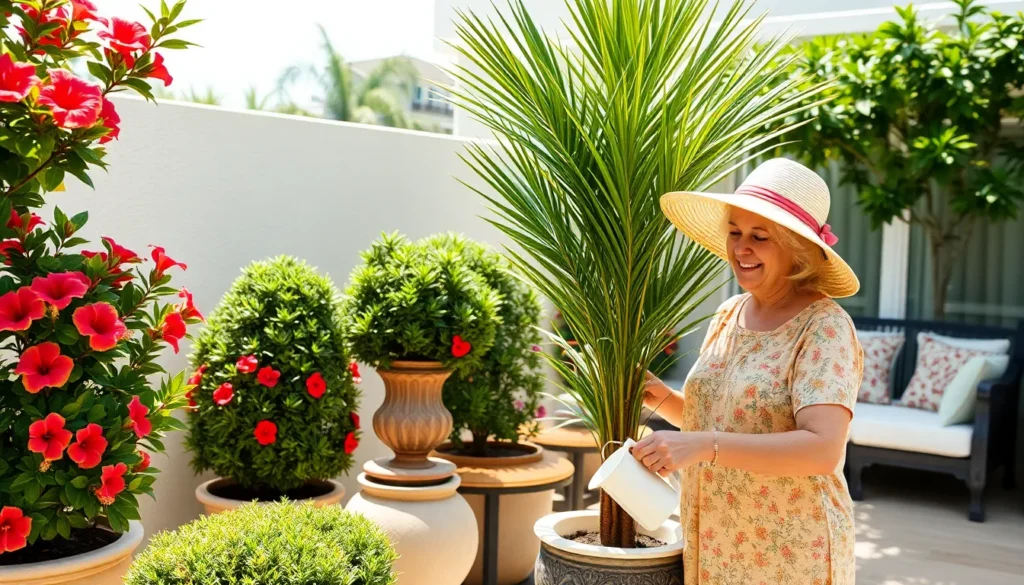Transform your outdoor space into a stunning sanctuary with big potted plants that command attention and create instant visual impact. We’ve discovered that oversized containers filled with lush greenery don’t just beautify patios and gardens – they completely revolutionize how you experience your outdoor living areas.
Whether you’re working with a sprawling deck or a compact balcony, large potted plants offer unmatched versatility and dramatic flair. We’ll show you how these statement pieces can define spaces, create privacy screens, and establish focal points that make your neighbors stop and stare.
Big outdoor planters aren’t just about size – they’re about creating an outdoor oasis that reflects your style while maximizing your space’s potential. From selecting the perfect containers to choosing plants that thrive in your climate, we’re here to guide you through every step of creating your own outdoor paradise.
Choose the Right Container Size for Your Big Potted Plants Outdoors
Selecting the appropriate container size ensures your outdoor plants thrive while maintaining the visual impact you’ve planned for your space.
Consider Drainage Requirements
Adequate drainage prevents root rot and waterlogged soil in your oversized outdoor containers. We recommend containers with drainage holes that are at least 1 inch in diameter for every 12 inches of pot width. Multiple holes work better than a single large opening since they distribute water flow evenly across the bottom surface.
Elevation improves drainage performance by allowing water to flow freely from your containers. Place pot feet or blocks underneath large planters to create 2 to 3 inches of clearance from the ground. This spacing prevents water from pooling beneath your containers during heavy rainfall.
Drainage layers enhance water movement through the soil in big outdoor pots. Add 2 to 4 inches of coarse gravel or broken pottery shards at the bottom before filling with potting mix. These materials create pathways for excess water while preventing soil from washing through drainage holes.
Select Weather-Resistant Materials
Fiberglass containers withstand temperature fluctuations better than ceramic or terra cotta options for year-round outdoor use. These lightweight materials resist cracking in freezing temperatures and won’t fade under intense UV exposure. Quality fiberglass planters can last 15 to 20 years with minimal maintenance.
Concrete planters offer durability for permanent outdoor installations but require proper sealing to prevent moisture damage. We suggest applying concrete sealer annually to protect against freeze-thaw cycles. These heavy containers work best in locations where you won’t need to move them seasonally.
Plastic resin provides affordability without sacrificing weather resistance for budget-conscious gardeners. Modern resin containers mimic natural materials like stone and wood while weighing 60% less than their authentic counterparts. Look for UV-stabilized options that won’t become brittle after prolonged sun exposure.
Plan for Plant Growth and Root Space
Root system requirements determine minimum container depths for healthy plant development outdoors. Deep-rooted plants like small trees need containers at least 24 inches deep, while shallow-rooted annuals thrive in 12 to 18 inch depths. We calculate width requirements by allowing plants to spread to 75% of the container’s diameter.
Growth projections influence long-term container sizing for perennial outdoor plants. Choose pots that accommodate 2 to 3 years of growth to minimize frequent repotting. A 20-gallon container supports most shrubs and small ornamental trees during their establishment period.
Seasonal considerations affect container capacity for plants that remain outdoors year-round. Containers need extra soil volume to insulate roots during winter months in cold climates. We recommend increasing pot size by 25% in zones 3 through 7 to provide adequate root protection from freezing temperatures.
Select Hardy Plant Varieties That Thrive in Large Outdoor Containers
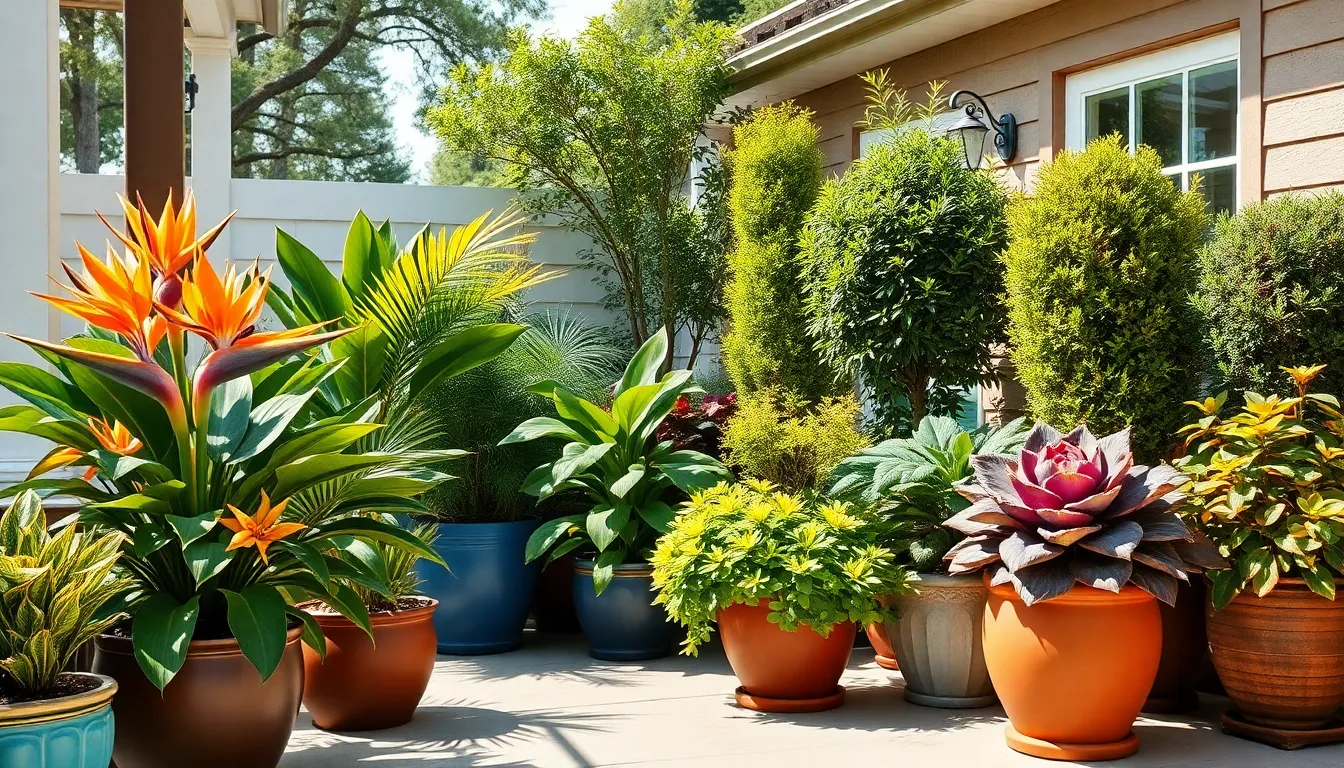
Choosing the right plants for our large outdoor containers ensures long-term success and reduces maintenance headaches. We need to match plant varieties to our exact climate conditions and gardening goals.
Tropical Plants for Warm Climates
Tropical species create stunning focal points in warm, frost-free climates where they can flourish year-round. Bird of paradise plants make dramatic statements with their large paddle-shaped leaves and exotic orange and blue flowers. Palms like the Mediterranean fan palm or Chinese windmill palm add instant tropical elegance to patios and pool areas.
Hibiscus varieties offer continuous blooms in vibrant colors throughout the growing season. We recommend frequent watering during hot seasons since these moisture-loving plants can quickly show stress in containers. Mulching around the base helps retain soil moisture and keeps roots cool during summer heat.
Container soil should be well-draining yet moisture-retentive to support these plants’ needs. We suggest using quality potting mix combined with compost to create the ideal growing medium for tropical varieties.
Cold-Hardy Options for Seasonal Changes
Cold-hardy plants withstand frost and temperature fluctuations while maintaining their beauty through seasonal changes. Boxwood shrubs provide year-round structure and can be shaped into elegant topiaries or hedges. Dwarf conifers like dwarf Alberta spruce or mugo pine add evergreen interest without overwhelming large containers.
Ornamental cabbages and kales offer colorful foliage that actually improves in cool weather. We can overwinter these hardy plants outdoors in large pots with mulch protection around the containers. Moving containers to sheltered areas during extreme cold provides additional protection.
Selecting species adapted to our local winters reduces the risk of plant damage and ensures container gardens last for years. We recommend checking plant hardiness zones before making final selections for cold-climate gardens.
Drought-Tolerant Species for Low Maintenance
Drought-tolerant plants thrive with minimal water once established, making them perfect for busy gardeners or water-conscious landscapes. Succulents like agave, aloe, and large jade plants create architectural interest while requiring little care. Lavender varieties provide fragrant flowers and silvery foliage that deer avoid.
Rosemary grows into impressive shrubs in large containers while offering fresh herbs for cooking. Ornamental grasses like fountain grass or blue fescue add movement and texture with minimal water requirements. We find these species particularly suitable for windy locations where containers dry out quickly.
Well-draining soil mixes prevent root rot in drought-tolerant plants that prefer drier conditions. Mulching helps conserve moisture during hot spells while reducing the need for frequent watering throughout the growing season.
Position Your Large Outdoor Planters for Optimal Growing Conditions
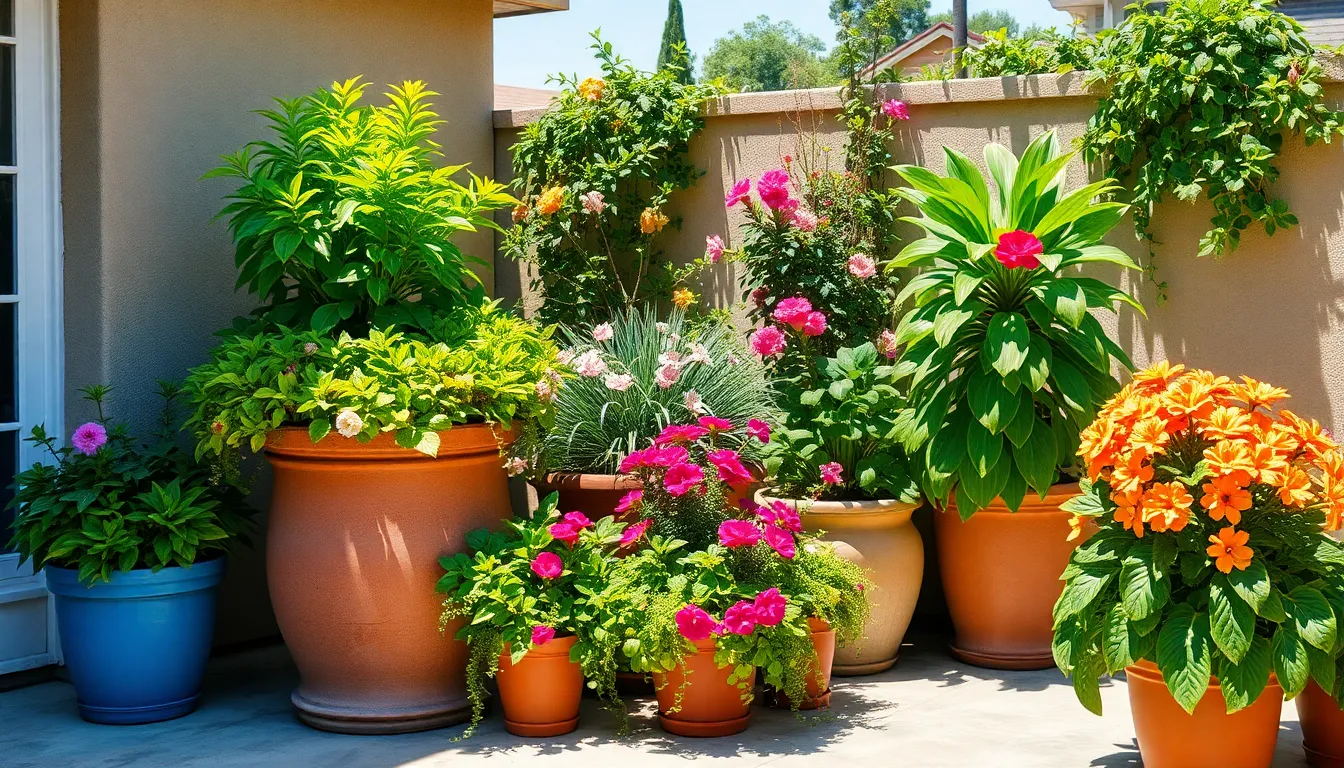
Once we’ve selected our containers and plants, proper positioning becomes crucial for their long-term success. Strategic placement ensures our large outdoor planters receive the optimal growing conditions they need to thrive.
Assess Sunlight Requirements
Determining how much sunlight our exact plants need forms the foundation of successful placement. Most outdoor potted plants thrive when we position them in locations that provide the right balance of sun and shade. Plants requiring full sun need at least 6-8 hours of direct sunlight daily, while partial shade varieties perform best with 3-6 hours of morning sun followed by afternoon protection.
Understanding our plants’ individual light preferences helps us create the perfect growing environment. Some tropical specimens like hibiscus and bird of paradise demand full sun exposure, while hostas and ferns flourish in shadier spots. We should observe our outdoor space throughout the day to identify areas that receive varying amounts of sunlight.
Providing some shade during hotter days helps prevent stress and dehydration in our container plants. Afternoon shade becomes particularly important in regions with intense summer heat, as it protects foliage from scorching while maintaining adequate light levels for photosynthesis.
Consider Wind Protection
Large outdoor pots require strategic placement in sheltered areas to protect our plants from harsh wind and rain. Wind exposure can quickly dry out soil in containers and cause important damage to delicate foliage and stems. Strong gusts also increase the risk of toppling heavy planters, potentially damaging both plants and surrounding areas.
Positioning our planters near walls, fences, patio furniture, or balcony corners shields plants from prevailing winds and creates a more stable microclimate. These barriers act as natural windbreaks while still allowing adequate air circulation around our plants. We can also use larger containers or plant groupings to create mutual protection among our collection.
Creating wind protection becomes especially important for tall plants or those with broad leaves that catch wind easily. Climbing plants on trellises and large leafy specimens benefit significantly from strategic placement behind protective structures.
Plan for Easy Watering Access
Watering large pots regularly proves crucial for plant health, especially in warm weather when evaporation increases water needs dramatically. We should position our containers where it’s convenient to water deeply and thoroughly. Proper watering means saturating the soil until water drains from the bottom holes, ensuring moisture reaches the deepest roots.
Locating planters within easy reach of water sources saves time and encourages consistent care routines. During hot summers, daily watering may become necessary for large containers, making accessibility a key consideration in our placement decisions. We should avoid positioning heavy planters in areas that require dragging hoses long distances or handling obstacles.
Timing our watering sessions correctly prevents common plant diseases and maximizes water absorption. We should water early in the morning when temperatures are cooler and avoid watering late in the day to prevent foliage diseases caused by prolonged moisture on leaves overnight.
Prepare Quality Potting Mix for Big Container Gardens
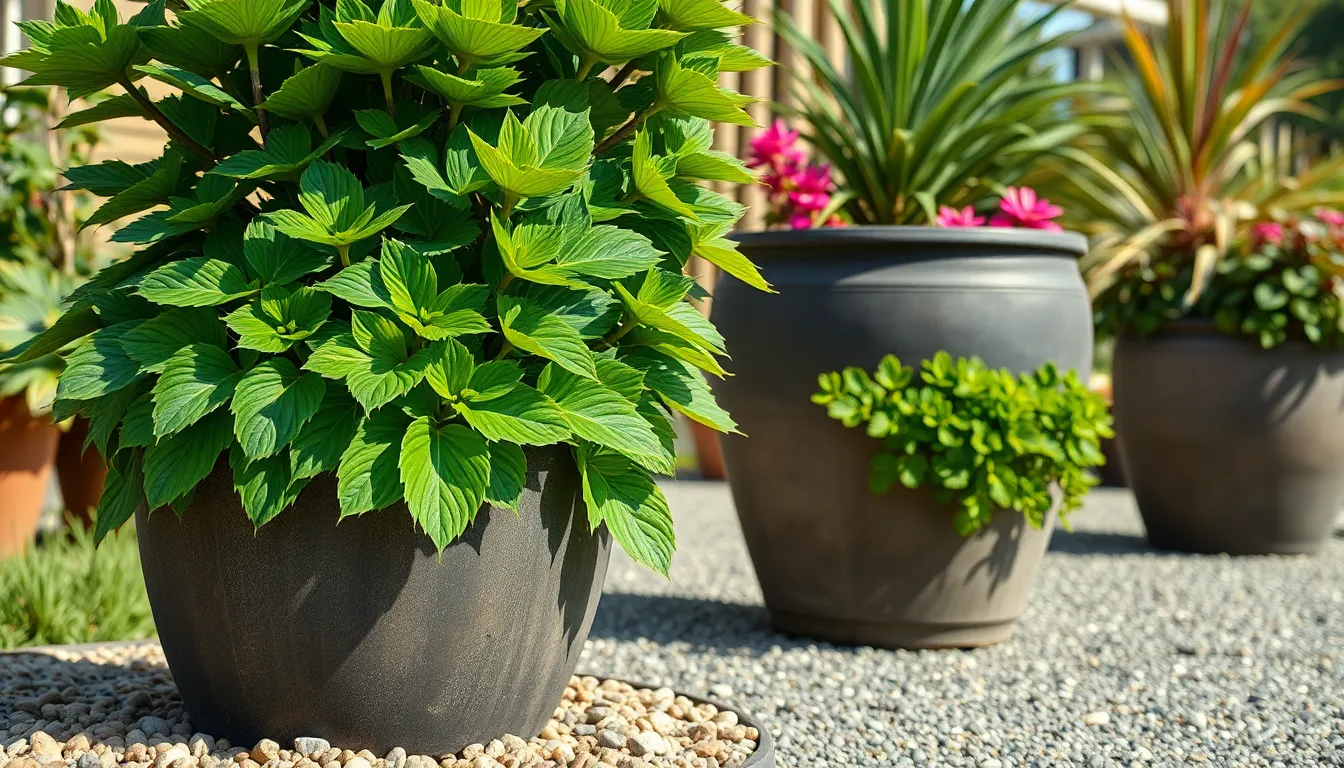
Creating the perfect foundation for our oversized planters starts with understanding that container soil differs dramatically from garden earth. We need specialized mixtures that provide superior drainage while retaining adequate moisture for thriving plant growth.
Layer Drainage Materials Properly
Starting with proper drainage materials prevents waterlogging that can suffocate plant roots in large containers. We place a layer of gravel, broken terracotta pots, or coarse sand at the bottom of each planter to create an effective water flow system. This foundational layer stops soil compaction at the container base and allows excess water to escape efficiently.
Elevating our containers slightly using pot feet or blocks enhances the drainage process even further. We ensure this drainage layer comprises about 10-15% of the total container depth for optimal root protection. Broken pottery shards work exceptionally well because they’re lightweight and create excellent air pockets.
Choose Nutrient-Rich Soil Blends
Selecting soilless potting mixes provides the lightweight structure our big containers require while delivering proper aeration and moisture retention. We incorporate slow release granular fertilizers directly into the potting mix at planting time to establish a steady nutrient supply over several months. Most commercial potting mixes lack essential nutrients, so we supplement with liquid water soluble fertilizers every 2-3 weeks during the growing season.
Combining peat free compost with materials like perlite or vermiculite creates the ideal balance of drainage and nutrition. We avoid using garden soil in containers because it becomes too heavy and compacted for proper root development. Quality potting blends should feel light in our hands and contain visible organic components.
Add Organic Matter for Long-Term Health
Incorporating organic matter like compost or well rotted manure improves soil structure while improving moisture retention and microbial activity. We refresh the top layer of container soil annually, mixing in slow release fertilizer and fresh compost to maintain plant vitality year after year. This practice supports robust root growth and increases nutrient availability throughout the growing season.
Organic amendments create beneficial microbial communities that help our plants absorb nutrients more effectively. We add about 20-30% organic matter to our container mix to ensure long term soil health. Well decomposed materials work best because they won’t rob nitrogen from our plants during the breakdown process.
Establish a Consistent Watering Schedule for Large Outdoor Plants
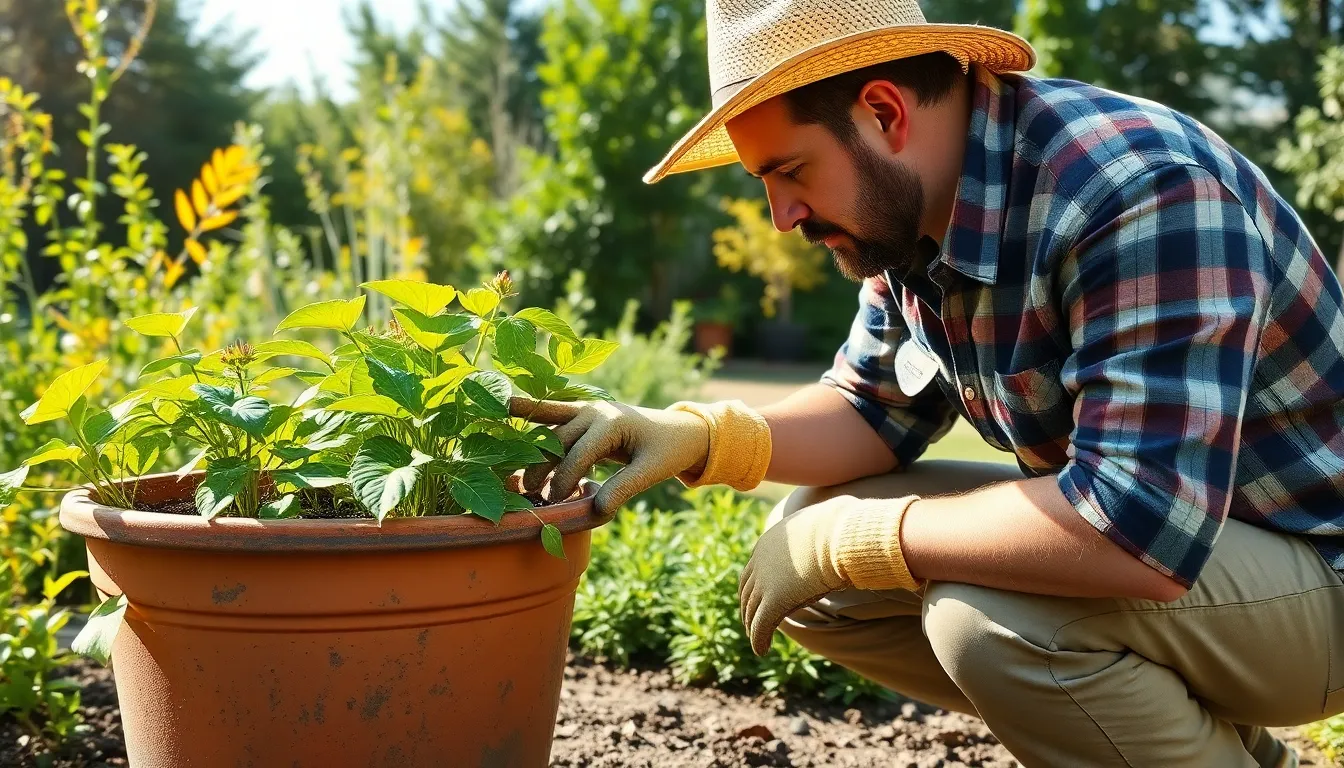
Large outdoor planters demand more frequent watering than in-ground plants since containers hold limited soil and moisture. We’ll need to water daily or even twice daily during hot weather to prevent drought stress in our container gardens.
Monitor Soil Moisture Levels
Check soil moisture regularly by inserting your finger into the top inch of the potting mix. When this surface layer feels dry, it’s time to water your large outdoor plants thoroughly. Water until excess moisture drains from the bottom holes, ensuring complete hydration throughout the root zone.
Signs of underwatering include shriveled leaves, limp stems, and dry discolored foliage that indicates your plants need immediate attention. Moisture gauges provide accurate readings when you’re unsure about soil conditions. Avoid soggy soil conditions that can lead to root rot by allowing proper drainage between watering sessions.
Adjust for Seasonal Weather Changes
Water requirements fluctuate dramatically with temperature changes and plant growth cycles throughout the year. During hotter seasons, our plants transpire more water and grow larger, increasing their daily water demands significantly. Cooler weather and rainy periods require less frequent watering since evaporation rates decrease naturally.
Monitor local weather patterns and adjust your watering frequency accordingly to match seasonal rainfall and temperature variations. Spring growth spurts often require increased watering as plants establish new foliage and root systems. Winter dormancy periods typically need minimal watering, especially for cold-hardy species that slow their growth.
Install Efficient Irrigation Systems
Drip irrigation systems deliver precise water amounts directly to plant roots while conserving water and reducing labor requirements. Automated watering systems can be programmed to operate based on weather conditions and exact plant needs throughout different seasons. These irrigation answers maintain consistent moisture levels without the daily commitment of manual watering.
Timer-controlled systems ensure early morning or early evening watering schedules that optimize water absorption and minimize evaporation losses. Consider installing moisture sensors that trigger watering only when soil conditions require additional hydration. Professional irrigation setups pay for themselves through water savings and improved plant health over time.
Protect Your Big Potted Plants From Extreme Weather
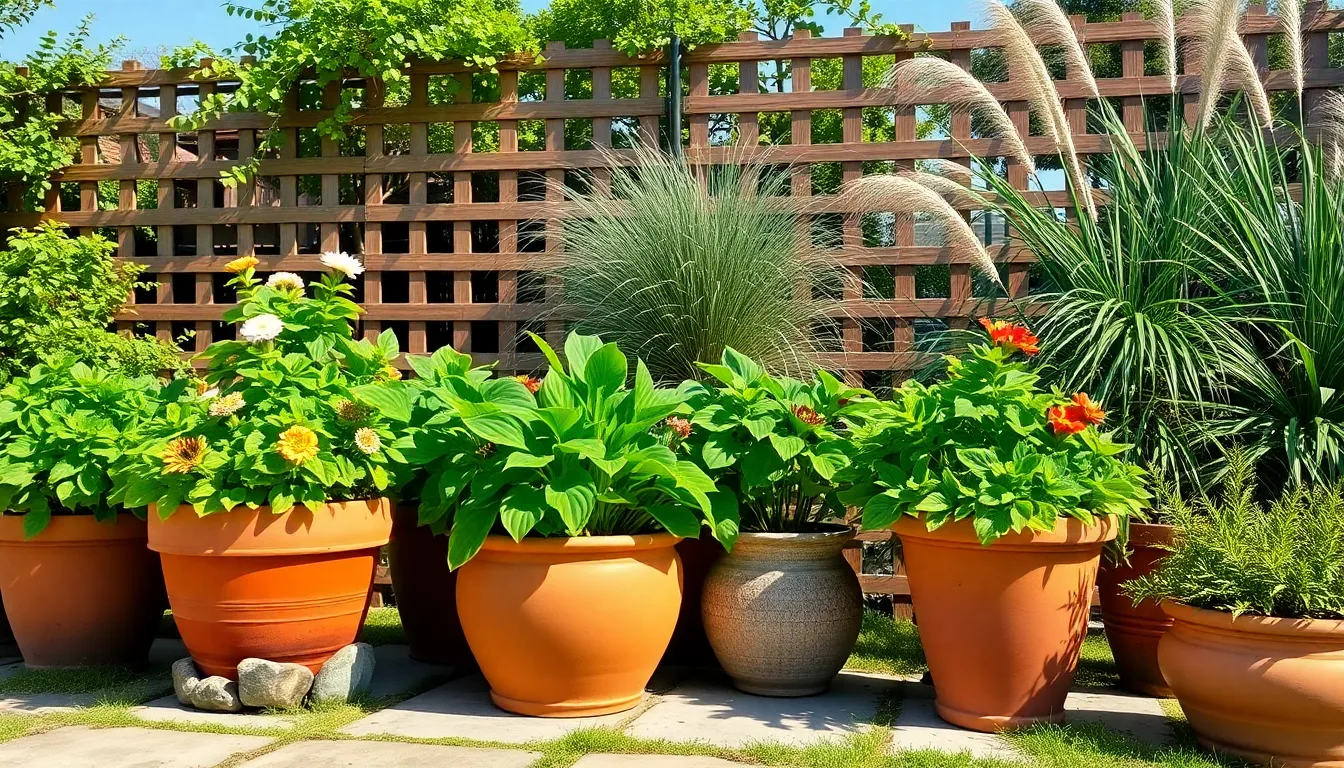
We’ve established the perfect outdoor container garden, but protecting our investment from nature’s extremes becomes crucial for long-term success. Weather protection strategies ensure our big potted plants survive harsh conditions while maintaining their beauty throughout the seasons.
Winterization Strategies
Moving containers indoors provides the most reliable winter protection after several hard frosts occur. Cold, unheated garages or cold frames create ideal storage environments that shield plants from freezing temperatures without exposing them to sudden temperature fluctuations.
Creating protective enclosures offers an alternative when indoor storage isn’t feasible. We can build windbreaks using straw bales around container clusters, then cover the entire setup with sturdy frost blanket fabric to prevent cold wind damage and frost penetration.
Watering occasionally during winter months prevents root systems from drying out completely. Warm winter days provide the perfect opportunity to check soil moisture and add water when needed, but we should avoid overwatering during dormant periods.
Timing spring maintenance correctly ensures smooth transitions back to growing season. We prune perennials before returning pots to their outdoor positions, and most perennials can remain in the same containers for two full seasons before requiring fresh soil or division.
Selecting well-drained soil mixes becomes especially important for winter survival since waterlogged roots quickly develop rot in cold conditions.
Summer Heat Protection
Deep watering practices keep container plants hydrated during extreme heat by ensuring water reaches root systems thoroughly. We water when soil surfaces feel dry, typically requiring daily attention during the hottest summer periods, and always ensure drainage from container bottoms.
Avoiding late-day watering prevents disease issues that develop when foliage remains wet through cool evening hours. Morning watering allows plants to absorb moisture before heat stress begins while giving leaves time to dry completely.
Fertilizing strategically supports heavy-feeding container plants through demanding summer conditions. Balanced, slow-release granular fertilizers applied at planting provide steady nutrition, while half-strength water-soluble fertilizers every two to three weeks supplement growing season needs.
Mulching soil surfaces creates a protective barrier that retains moisture and keeps root zones cool during heat waves. We refresh top soil layers and add slow-release fertilizer in early spring before applying fresh mulch for optimal growing season preparation.
Storm and Wind Preparation
Positioning containers strategically reduces wind exposure by placing pots in sheltered locations or grouping them together for mutual protection. Natural windbreaks like walls, fences, or larger plants create calmer microclimates for our container gardens.
Choosing heavier containers provides natural stability that prevents tipping during strong winds. Large, substantial pots resist movement better than lightweight alternatives, or we can anchor existing containers with weights when severe weather approaches.
Relocating during severe storms protects valuable plants when conditions become extreme. Moving containers to protected areas or bringing them indoors temporarily prevents damage that could take seasons to repair.
Maintaining soil stability through proper mulching and soil management helps prevent root disturbance when winds rock containers, ensuring our plants remain securely anchored even during challenging weather events.
Maintain Healthy Growth Through Regular Care and Pruning
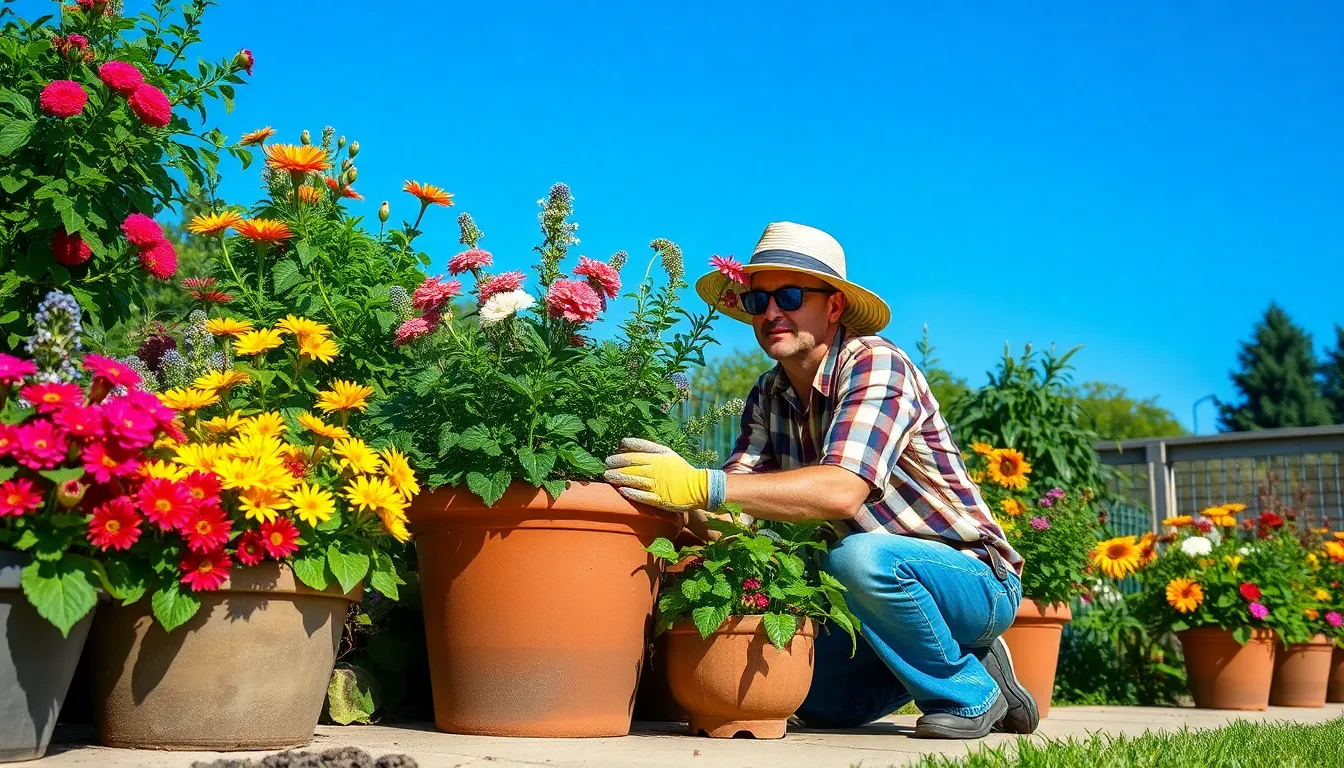
Once we’ve positioned our large containers and established proper watering routines, we must focus on ongoing maintenance to keep our plants thriving. Regular care and strategic pruning form the foundation of successful container gardening.
Fertilization Schedule for Container Plants
Container plants require more frequent feeding than their in-ground counterparts since nutrients leach out through drainage holes. Start with a balanced slow-release granular fertilizer at planting time to provide several months of steady nutrition. Apply this base fertilizer according to package directions to establish a strong foundation.
Supplement with water-soluble fertilizer at half strength every two to three weeks during the growing season, beginning about one month after planting. This dual approach ensures our plants receive both immediate nutrients and long-term feeding support.
Refresh the feeding schedule each spring by removing the top 2-3 inches of soil and adding fresh slow-release fertilizer mixed with compost. Follow this with a mulch layer to retain moisture and continue feeding soil microorganisms throughout the season.
Pruning Techniques for Size Control
Regular pruning keeps our large potted plants manageable while promoting healthy growth patterns. Remove spent blooms weekly during the flowering season to encourage continuous blooming and prevent energy waste on seed production.
Trim back leggy growth and overcrowded branches to maintain the plant’s shape and improve air circulation. Don’t hesitate to cut back healthy growth when it becomes too vigorous, as this actually stimulates new branching and fuller development.
Shape plants during their dormant season for major structural pruning, focusing on removing dead wood and crossing branches. Monitor growth weekly during peak growing periods to catch issues early and maintain the desired size without shocking the plant.
Pest and Disease Prevention
Healthy cultural practices significantly reduce pest and disease problems in container gardens. Water only when the soil surface feels dry to prevent overwatering, which leads to root rot and creates conditions favorable for fungal diseases.
Time watering sessions for early morning to allow foliage to dry before evening, reducing the risk of foliar diseases that thrive in prolonged moisture. Inspect plants once or twice weekly for early signs of pest activity, increasing frequency during heat waves when stress makes plants more vulnerable.
Position containers in areas with good air circulation but protection from harsh winds and heavy rain. Apply mulch around plants to retain soil moisture and create a barrier against soilborne pests while supporting beneficial microorganisms that naturally suppress harmful pathogens.
Conclusion
We’ve covered everything you need to create a stunning outdoor container garden that’ll thrive year-round. From selecting the perfect planters and hardy plants to mastering watering schedules and weather protection these strategies will help you build an impressive garden display.
Remember that success comes from consistent care and attention to your plants’ exact needs. The investment in quality containers and proper soil preparation pays off with healthier plants and less maintenance headaches down the road.
Your outdoor space has incredible potential waiting to be unlocked. With these proven techniques you’re ready to transform any patio deck or garden area into a lush green sanctuary that reflects your personal style and brings joy throughout the seasons.
Frequently Asked Questions
What size containers should I use for large outdoor plants?
Choose containers that are at least 18-24 inches wide and deep for most large plants. The container should be proportional to the plant’s mature size, with enough space for root growth. Deeper containers are essential for plants with extensive root systems, and the pot should be wide enough to provide stability against wind.
What materials work best for large outdoor planters?
Fiberglass, concrete, and high-quality plastic resin are ideal choices for outdoor containers. These materials are weather-resistant, durable, and can withstand temperature fluctuations. Avoid materials that crack in freezing temperatures or deteriorate quickly under UV exposure. Consider weight if you plan to move containers seasonally.
How often should I water plants in large outdoor containers?
Container plants typically need watering 2-3 times per week, but this varies based on weather, plant type, and container size. Check soil moisture regularly by inserting your finger 2 inches deep. During hot summer months, daily watering may be necessary, while winter watering should be reduced significantly.
What type of soil should I use for large container gardens?
Use high-quality, soilless potting mix designed for containers rather than garden soil. The mix should provide good drainage while retaining moisture. Add compost for nutrients and consider slow-release fertilizer. Layer drainage materials like gravel at the bottom to prevent waterlogging and root rot.
Which plants thrive best in large outdoor containers?
Choose plants suited to your climate zone. For warm areas, try tropical plants like bird of paradise, palms, or hibiscus. Cold climates work well with boxwood shrubs and dwarf conifers. Drought-tolerant options include succulents, lavender, and ornamental grasses, which require minimal maintenance and water.
How do I protect large potted plants during winter?
Move containers to sheltered locations or indoors if possible. For plants staying outside, wrap containers in burlap or frost blankets, and group pots together for protection. Elevate containers off the ground to prevent freezing, and water occasionally during winter to prevent roots from completely drying out.
Where should I position large outdoor planters for best results?
Place containers where plants will receive appropriate sunlight for their specific needs. Most plants prefer morning sun and afternoon shade. Position planters near walls or fences for wind protection, and ensure easy access to water sources. Avoid areas with excessive wind exposure or extreme temperature fluctuations.
How do I ensure proper drainage in large containers?
Ensure containers have multiple drainage holes in the bottom. Add a 2-3 inch layer of gravel, broken pottery, or drainage stones before adding soil. Elevate containers slightly off the ground using pot feet or blocks to improve water flow and prevent waterlogging that can cause root rot.

